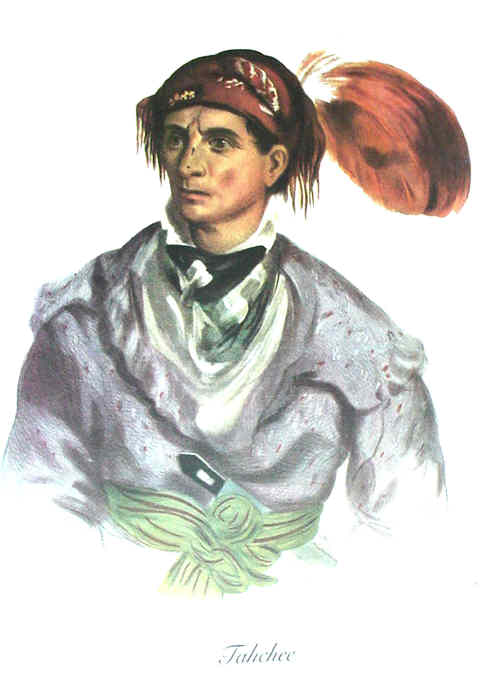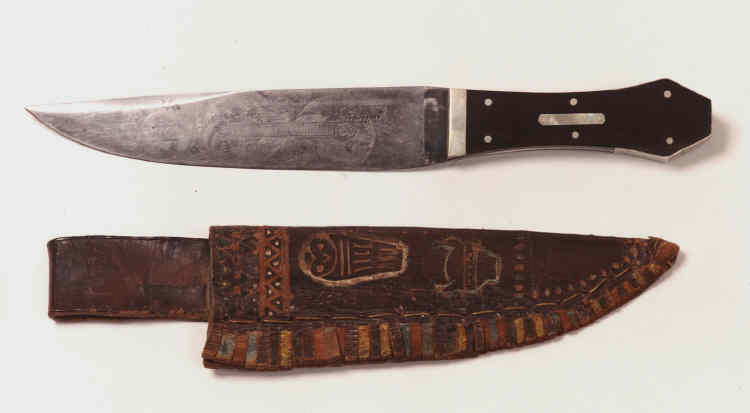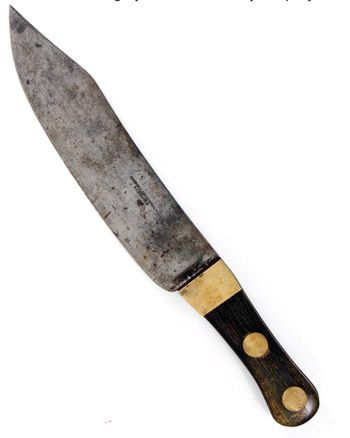Birdwatcher
45 Cal.
- Joined
- Dec 25, 2003
- Messages
- 643
- Reaction score
- 7
Coffin handled Bowie knives without guards were being made in Arkansas by the early 1830's, this style often known as the Tahchee or "Cherokee" Bowie as a notable Cherokee of that name was painted while wearing one in 1837...
http://www.antiquebowies.com/antiqueBowies/historic/tahchee/tahchee.htm
http://www.antiquebowies.com/antiqueBowies/earlySheffield/Graveley/graveleyAndWreaks.htm

...at least one of these apparently making its way to England such that, by 1836 two men (Englishmen?) in New York City, John Gravely and Charles Wreaks were importing "Bowie knives" "in a great variety", including this one....

More from the second link above, note how quickly the market ws flooded and/or the Bowie fad ended....
From 1836 to 1838 the importer, John Graveley, lived at Number 1 Park Place, one street North of Barclay. In 1833, Charles Wreaks sold goods as a Merchant at 82 William Street. In 1834 and 1835, Charles became an importer at 7 Platt Street. John Graveley came to New York in 1835 or 1836. John and Charles established a partnership in 1836 and disappear from the New York City Directory in 1839. If they were Englishmen, they may have returned to England.
The Bank panic of 1837 and 1838 caused many a business to fold. By 1838 the deadly use of the Bowie knife in murders and duels by ruffians and gentlemen caused a popular revulsion and legal furor. In 1838 the state of Tennessee passed an act to suppress or ban the sale and deadly use of Bowie-Knives and Arkansas Tooth-Picks. The Alabama and Mississippi Laws passed in 1837-1838 were not as strict as in Tennessee. These Laws curtailed the advertising and sales of the Bowie knife, Arkansas Toothpick and Dirks in the United States. The sales of Bowie knives continued in the frontier states of Arkansas, Louisiana and the Republic of Texas. With the arrival of Samuel Colt's multi-shot revolver, the Bowie knife lost its roll as a backup defensive weapon. A Bowie knife valued at $20 in 1837 sold for $1.50 in 1838.
I'm arriving at a conclusion that those knives meant primarily as weapons rather than utilitarian tools tended to be purposefully decorated, certainly a leap in heft and decoration from your average trade knife.
Note that at least some of these Bowies went West with the fur trade, and another name associated with the design of these knives; August Pierre Chouteau....
It is more likely that the primary purchaser of G&W’s knives was John Jacob Astor and the Bowie knife designs were provided by Auguste Pierre Chouteau. G&W were tenants of Astor in the Astor House. Astor, the Fur Titan, provided A P Chouteau with Indian Trade Goods. Chouteau owned a Trading Post at the three Forks of the Arkansas River above Fort Gibson in Oklahoma. These goods were transported from St Louis via the Missouri and Osage Rivers and by pack trains and Wagons. Steamboats on the Arkansas River also delivered goods to the trading post located near present day Chouteau Oklahoma.
Birdwatcher
http://www.antiquebowies.com/antiqueBowies/historic/tahchee/tahchee.htm
http://www.antiquebowies.com/antiqueBowies/earlySheffield/Graveley/graveleyAndWreaks.htm

...at least one of these apparently making its way to England such that, by 1836 two men (Englishmen?) in New York City, John Gravely and Charles Wreaks were importing "Bowie knives" "in a great variety", including this one....

More from the second link above, note how quickly the market ws flooded and/or the Bowie fad ended....
From 1836 to 1838 the importer, John Graveley, lived at Number 1 Park Place, one street North of Barclay. In 1833, Charles Wreaks sold goods as a Merchant at 82 William Street. In 1834 and 1835, Charles became an importer at 7 Platt Street. John Graveley came to New York in 1835 or 1836. John and Charles established a partnership in 1836 and disappear from the New York City Directory in 1839. If they were Englishmen, they may have returned to England.
The Bank panic of 1837 and 1838 caused many a business to fold. By 1838 the deadly use of the Bowie knife in murders and duels by ruffians and gentlemen caused a popular revulsion and legal furor. In 1838 the state of Tennessee passed an act to suppress or ban the sale and deadly use of Bowie-Knives and Arkansas Tooth-Picks. The Alabama and Mississippi Laws passed in 1837-1838 were not as strict as in Tennessee. These Laws curtailed the advertising and sales of the Bowie knife, Arkansas Toothpick and Dirks in the United States. The sales of Bowie knives continued in the frontier states of Arkansas, Louisiana and the Republic of Texas. With the arrival of Samuel Colt's multi-shot revolver, the Bowie knife lost its roll as a backup defensive weapon. A Bowie knife valued at $20 in 1837 sold for $1.50 in 1838.
I'm arriving at a conclusion that those knives meant primarily as weapons rather than utilitarian tools tended to be purposefully decorated, certainly a leap in heft and decoration from your average trade knife.
Note that at least some of these Bowies went West with the fur trade, and another name associated with the design of these knives; August Pierre Chouteau....
It is more likely that the primary purchaser of G&W’s knives was John Jacob Astor and the Bowie knife designs were provided by Auguste Pierre Chouteau. G&W were tenants of Astor in the Astor House. Astor, the Fur Titan, provided A P Chouteau with Indian Trade Goods. Chouteau owned a Trading Post at the three Forks of the Arkansas River above Fort Gibson in Oklahoma. These goods were transported from St Louis via the Missouri and Osage Rivers and by pack trains and Wagons. Steamboats on the Arkansas River also delivered goods to the trading post located near present day Chouteau Oklahoma.
Birdwatcher
Last edited by a moderator:









